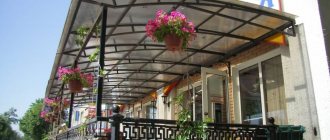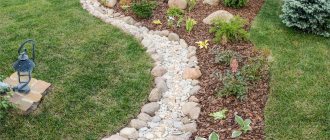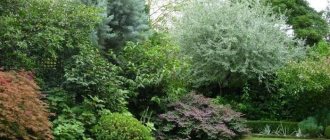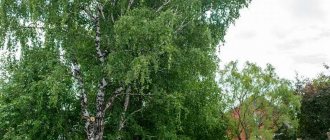The garden has personality
The garden is created specifically for the life and relaxation of family and friends. Each summer resident, depending on the site, selects the design and location of certain zones. A non-standard creative approach to the design of a site will help create an unusual landscape that will delight you with beauty and convenience. Gardeners strive to create unique, different styles with their own hands, using the main directions and mixing them. The main thing is that the site does not look tasteless.
Much attention is paid to decorative elements. The garden is decorated with original flowerpots, flowerpots, hanging baskets, birdhouses, and bird feeders. The highlight of the suburban area will be a green sculpture. To create it, evergreen shrubs and trees are used. You can give the plants an unusual shape with your own hands and get a unique decoration for the site. Fashion trends in landscape design are not the main thing; imagination and room for experimentation are important.
Modern landscape design components
Land design is a complex of works to improve the territory by any available means. Before starting work, you need to think through all the constituent elements of the composition, which should be harmoniously combined with each other. The homeowner must smooth out strict geometric shapes and lines to make the area look natural. Objects on a personal plot should have a natural appearance to create the impression that the house is located among living, untouched nature.
Required elements of modern landscape design:
- Trees and shrubs. The modern style assumes environmental friendliness, therefore, only old and dry trees can be removed from the site. For decoration, you can use both coniferous (spruce and pine) and deciduous (maple and linden, lilac) species, as well as fruit and berry (apple and cherry). It is better to plant shrubs where they can emphasize the shape of the relief.
- Reservoirs (swimming pool, pond, decorative swamp, natural mini-waterfall, etc.).
- Decorative architectural structures
- Garden paths and paths. It is worth noting that they have not only a functional, but also a decorative purpose, so you need to carefully approach the choice of materials used for laying paths. It is important that they are combined with the facade of the housing, complementing the landscape composition of the site.
Modern technologies are used in the garden
Technologies are used in construction and site maintenance. A modern garden is the use of the latest technologies. The design uses Corten steel, which is covered with an oxide film when exposed to water, that is, rust. When arranging the landscape, it is used to create architectural forms, lanterns, and retaining walls.
An automatic garden watering system will make the gardener’s work easier and will keep plants and flowers in perfect condition; they will not be dehydrated in the heat, and the soil will not dry out. There are also many other modern technologies that are used in the garden.
Recent Entries
5 working ways to use tar in the garden 7 indoor plants that help you get married even in adulthood Indoor plants that can bloom in trouble
Author's garden
Today, individuality is in fashion, matching the place, architecture, time - an author's garden, endowed with unique features, evoking emotions. And the question is not the choice of color, whether or not to plant orange or purple flowers - the point is in the approach to the landscape, attitude towards plants, materials, introduction of new technologies, use of modern design techniques.
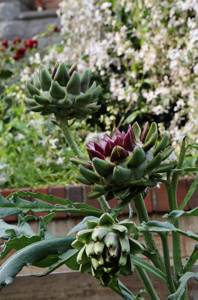
Photo: Evgeny Korneev/burda media
Fashion does not come by chance, overnight. She, like a litmus test, reacts to all changes occurring in society, and garden fashion even more so. The rapid development of cities, the increase in environmental problems, at the same time the emergence of new materials, technologies, changes in the economy, culture and even politics - everything resonates in landscape architecture.
Overloaded gardens that require complex care are being replaced by simple, functional ones that correspond to the crazy pace of life and the policy of saving the landscape.
Set of tools"
New design techniques, dynamic rhythm of paving, contrasts of clear planning geometry and natural content, bright colors of small architectural forms and soft natural shades of perennials and grasses create the image of a modern garden. Planting plants in masses, not tied to paths, adds a sense of spontaneity and naturalness. The combination of trimmed forms of woody plants and arrays of perennials enhances the contrast between natural and man-made.
The garden uses biological protection agents and organic fertilizers
Organic fertilizers include manure, compost, peat, straw, green manure and household waste. Organic substances contained in fertilizers have a positive effect on the properties of the soil and on the water and air nutrition of plants.
To combat pests in the garden and vegetable garden, it is worth using biological means of protection. Predatory insects that feed on pests or their eggs, larvae or caterpillars are used against pests. Infection of pests with pathogenic bacteria is used, causing their mass death. Attracting insectivorous birds to the garden is one method of protecting the garden. The advantage of this method is environmentally friendly products.
Natural style gardens
A city dweller, tired of smog, asphalt, concrete and the view of the neighboring panel house from the window, dreams of feeling like he is in nature in a suburban area. It's no wonder that nature-style gardens, which give the feeling of a natural meadow or forest, are so in demand lately. The desire to create lush, overloaded mixborders, to use plant varieties with brightly colored foliage or flashy flowers of gigantic size gradually disappears. In addition, large inflorescences often cannot withstand the effects of rain and wind and require supports, tying, and therefore additional labor costs.
Garden of sensations
The theme of sensations in the garden is one of the most popular, because in it you can influence all the senses, evoke all types of external sensations: visual, auditory, olfactory, tactile (tactile), gustatory and kinesthetic, in fact, create sensory gardens that allow you to awaken memories , emotions and feelings, revive and develop connections with nature.
Today there is a fashion for gardens that are individual, different from each other, functional and comfortable, which bring people joy.
Aesthetics meets functionality in the garden
Recently, varieties of vegetable crops with enhanced decorative properties are gaining popularity and they are combined with flowers that not only attract pollinators, but protect against pests. You can install rain gardens that are designed to collect and filter rain from roofs, paths and areas. Thus, the water does not enter the storm drain, but remains on the site. This will make the work easier and help you avoid watering the garden if it is on a slope. It is better to select plants that can withstand temporary flooding. It is possible to create a bioplateau in which aquatic and marsh plants in a pond are used to purify the water.
Comfort and coziness should be created in the garden plot so that family and friends can have a pleasant time. And if you follow some rules, this is not difficult to do.
- Author: iarriba
Rate this article:
- 5
- 4
- 3
- 2
- 1
(13 votes, average: 1.3 out of 5)
Share with your friends!
Modern vegetable garden as an element of landscape design
It is difficult to imagine a garden plot without a vegetable garden, because flowers and shrubs play only a decorative role, and the garden area should also bring benefits. A small garden with vegetables and fruits will not spoil the appearance of the garden, but rather complement it. It is better to place the beds on the sunny side of the site, delimiting the space for a neat appearance and ease of planting. All beds should be the same size and rectangular in shape; you can also arrange high beds.
To decorate the beds, you can use brick and special modular sections, containers and huge pots. Garden paths are laid between the beds, which can be made from crushed stone or wood cuts. As for the choice of plant crops, it all depends on the soil, homeowner preferences and climatic conditions. For better yield, compatible crops need to be placed next to each other, among which the following duets can be distinguished:
- Beets and radishes.
- Cucumbers and cabbage.
- Carrots and tomatoes.
- Beans and potatoes.
- Onions and parsnips.
- Peas and celery.
